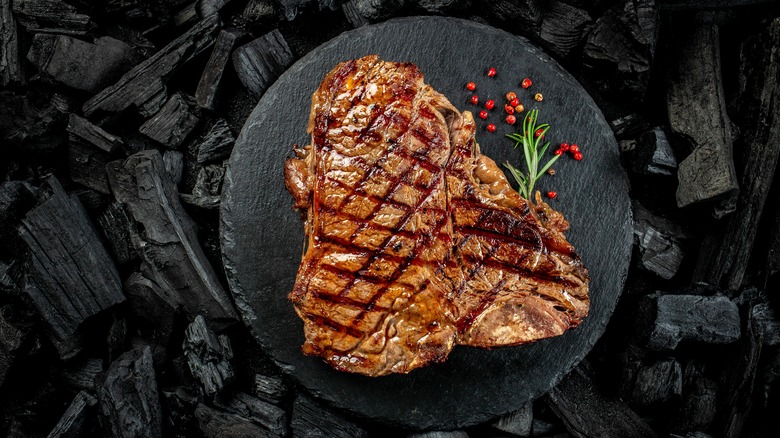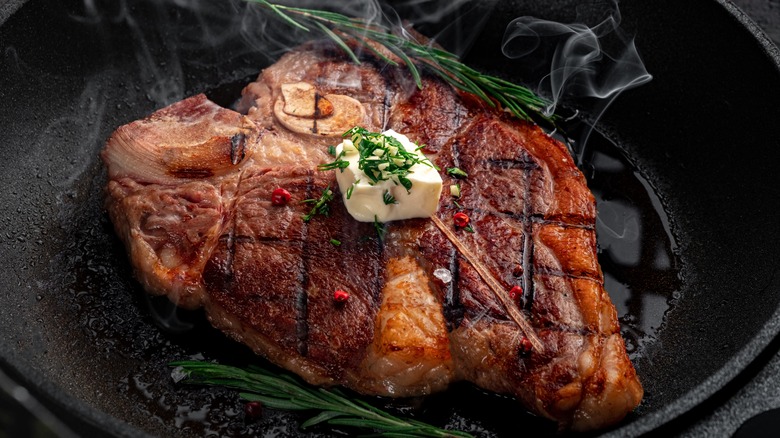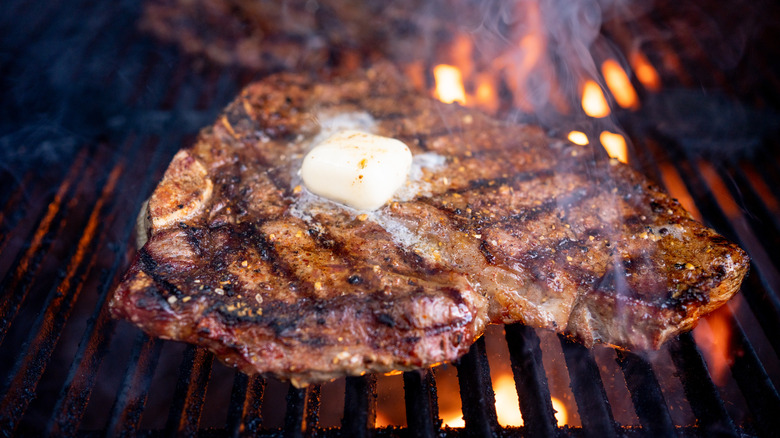Grilling Vs Pan-Searing: The Best Way To Cook A T-Bone Steak
As far as steak cuts go, T-bones are legendary. The cut is sourced from the short loin and features the meat from the buttery tenderloin on one side, and a richly marbled strip on the other, separated by a T-shaped bone. What you end up with is a beautiful balance between tenderness and flavor. Coupled with their large size, this naturally makes T-bone steaks one of the best and most sought-after cuts of steak out there, short of the filet mignon. If you're planning to tackle a T-bone at home for the first time, it's natural to feel a bit nervous that you won't be able to make good on your investment.
Fortunately, the way to cook a T-bone steak isn't all that different from other cuts. You can pan-sear, grill, broil, sous-vide, and smoke it. Most people will consider pan-searing or grilling first since they're the ones that'll give the steak the beautifully charred crust that you would have seen in cookbook photos and cooking show montages. But here's the thing: between pan-searing and grilling a T-bone, go for grilling every time. It'll take some effort to fire up the grill, but the way the T-bone is structured makes it really difficult to pan-sear correctly.
Why T-bones are so difficult to pan-sear
The core tenet of pan-searing is that the meat has to have as much direct contact with the hot pan as possible to get an even sear across its entire surface. While this is easy with other beef cuts like a flank steak, you'll run into a lot of trouble with a T-bone. The culprit? That same T-shaped bone that gives the cut its name.
As the steak cooks, it naturally shrinks a bit. This causes the bone to lift parts of the meat away from the pan's surface. The result is an unevenly cooked steak with some areas that have begun to brown and caramelize, while others still look pale and undercooked.
If your grill is out of commission and you have no choice but to pan-sear, you can use tongs to press down on the steak near the bone to force the meat to make contact with the pan. If you want to be hands-off, you can just remove the bone altogether. Although it gives the steak its shape, the bone doesn't contribute much in the way of flavor when you pan-sear it, according to America's Test Kitchen. Rest assured that you're not missing out much if you get rid of it.
Grilling is better, but not without its challenges
While grilling is the better way to cook a T-bone versus pan-searing, it has its own challenges. Because a T-bone is a cross between a tenderloin and a strip, you'll have to consider how the two parts will behave on the grill when you cook the steak. Due to the fat on steak, marbled cuts, like the strip, tend to cook slower than leaner ones like the tenderloin. Balancing the heat so that both parts of the cut can cook properly is crucial if you want your T-bone to come out right.
Fortunately, with a smart grilling set-up and good positioning on the grates, you can get a well-seared T-bone steak. Start by creating two heat zones on your grill: one hot with the burner on high, and one cool with the burner off. Then, place your steak so that the T-shaped bone is in the middle of the grill and the steak spans the two heat zones with the fatty strip side facing the hotter zone, while the lean tenderloin sits over the cooler area. This way, the fatty strip has the heat it needs to cook through, while the leaner tenderloin can cook at its own pace with gentler heat. In about 15 minutes, you'll have a succulent steak ready to be plated!


